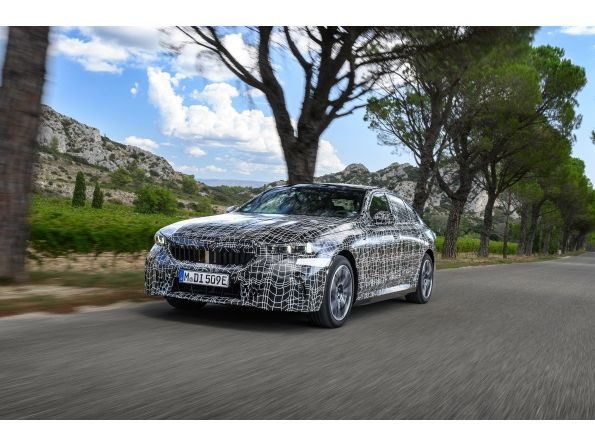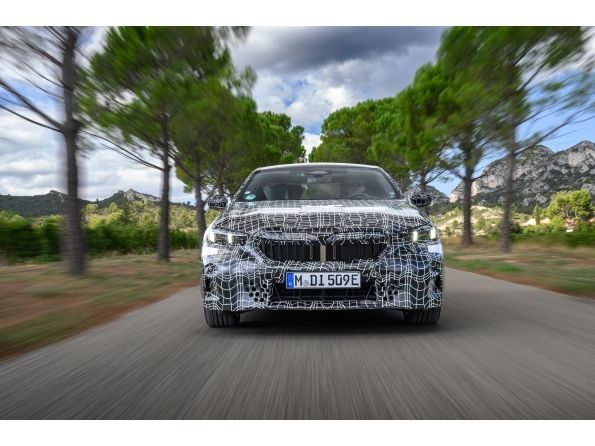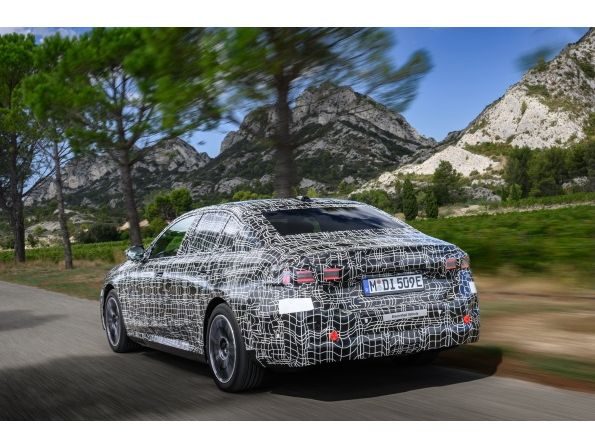Categories more
- Adventures (17)
- Arts / Collectables (15)
- Automotive (37)
- Aviation (11)
- Bath, Body, & Health (77)
- Children (6)
- Cigars / Spirits (32)
- Cuisine (16)
- Design/Architecture (22)
- Electronics (13)
- Entertainment (4)
- Event Planning (5)
- Fashion (46)
- Finance (9)
- Gifts / Misc (6)
- Home Decor (45)
- Jewelry (41)
- Pets (3)
- Philanthropy (1)
- Real Estate (16)
- Services (23)
- Sports / Golf (14)
- Vacation / Travel (60)
- Watches / Pens (15)
- Wines / Vines (24)
- Yachting / Boating (17)
Published
05/03/2023 by BMW (UK) LtdThe series production development process for the first-ever BMW i5 is entering the home straight with the fine-tuning of its suspension control and driver assistance systems. Just a few weeks ahead of the car’s world premiere, it is clear the all-electric version of the new BMW 5 Series Sedan will deliver an outstanding driving experience – just like all the other variants. Innovative Vertical Dynamics Management elevates the balance of sporting potency and ride comfort for which the BMW 5 Series has always been renowned to an even higher level. And the car’s automated driving capability has also been taken into a new dimension with the Highway Assistant, whichcontrols the distance to the vehicle ahead, carries out steering adjustments and carries out lane changes for the first time by means of eye activation.
Over the course of more than a year, the BMW i5 has negotiated a richly varied programme of testing – from the snow-covered and icy surfaces of the winter test centre at Arjeplog, Sweden to regions offering extreme heat and dry conditions, in city driving and on country roads, on motorways and hand-picked test tracks. The fine-tuning work for all the components involved in the drivingexperience was then carried out at the BMW Group’s proving grounds outside Miramas in southern France. This included ensuring the integral heating and cooling circuit with heat pump function for the drive system, the high-voltage battery and the interior of the BMW i5 can be controlled as required at all times. The predictive heat management capability of the high-voltage battery paves the way for rapid and efficient charging at DC fast-charging stations.
Specially tuned suspension systems maximise comfort and agility.
The flexible drive system technology offered by the new BMW 5 Series range – which now gives customers the choice between classical internal combustion engines, plug-in-hybrid solutions and fully electric drive systems – leads to wide variations in vehicle weight. With this in mind, model-specific, case-by-case chassis tuning and corresponding application of all control systems deliver signature BMW driving pleasure, regardless of the drive concept involved.
As the range-topping model variant, the BMW i5 M60 xDrive (electric power consumption combined: 21.2 – 17.9 kWh/100 km; CO2 emissions: 0 g/km in the WLTP cycle [provisional figures]) is fitted as standard with Adaptive Suspension Professional including electronically controlled dampers. This suspension system can also be specified as an option for the BMW i5 eDrive40 (electric power consumption combined: 19.7 – 16.0 kWh/100 km; CO2 emissions: 0 g/km in the WLTP cycle [provisional figures]). Thanks to an innovative form of BMW Vertical Dynamics Management, it offers a noticeable increase in sports performance combined with a level of ride comfort that also represents a clear step forward from that of its predecessor.
The latest version of BMW’s Vertical Dynamics Management, now in its ninth generation, is making its debut in the new BMW 5 Series Sedan. This technology is based on a newly developed, extensively networked control logic, and factors in all the available input variables – such as wheel speeds, steering angle, yaw rate and acceleration – to establish the ideal damping forces. The system no longer calculates the required damping forces using mathematical models, but instead favours physical calculation of data on the current driving condition. This ensures clearly defined body control and precise suspension response in every driving situation.
Adaptive Suspension Professional is offered for all variants of the new BMW 5 Series Sedan (either as standard or optionally, depending on the model), ensuring the customary driving pleasure of BMW. The new generation of the business sedan therefore blends ride comfort approaching BMW 7 Series levels with the sporting agility familiar from the BMW 3 Series.
A new experience of automated driving: Highway Assistant and automated lane change with eye activation.
The new BMW 5 Series Sedan also raises the bar in its segment with its extensive array of systems for automated driving and parking. High-resolution cameras, high-precision radar sensors and control units from the BMW Group’s latest technology toolkit, plus a software application refined over countless miles of testing, provide the ingredients for an automated driving experience featuring innovative highlights that further enhance safety and comfort.
In the USA and Canada, and now also in Germany, the Driving Assistant Professional available as an option for the new BMW 5 Series Sedan comprises Highway Assistant, which can be used at speeds of up to 130 km/h (85 mph). Once activated, the system takes care of distance control and the steering inputs required for lane control, so the driver can keep their hands in a comfortable position and focus fully on surveying the area around the vehicle and the traffic situation at hand.
An interior camera helps monitor the driver’s level of alertness and also enables another innovation: in a world first, the automated lane change – included as part of the Driving Assistant Professional and Highway Assistant – in the new BMW 5 Series Sedan can be controlled using eye activation. This convenience feature results in a new level of interaction between human and car. Looking in the exterior mirror prompts the car to initiate the lane change process and carry out the necessary steering movements and speed adjustments at speeds of up to 130 km/h (85 mph) once the driver has confirmed they want it to do so and the traffic situation allows. The purely visual gesture complements the previous use of the turn signal lever, which is also available as an alternative.
Production of the new, eighth-generation BMW 5 Series Sedan will begin in summer 2023 at BMW Group Plant Dingolfing in Bavaria. The car’s market launch will get underway in October 2023.
The fuel consumption, CO2 emissions, electric power consumption and operating range figures are determined according to the European Regulation (EC) 715/2007 in the version applicable. They refer to vehicles in the German market. Where a range is shown, the figures take into account the impact of any optional extras.
All values were calculated based on the new WLTP test cycle. WLTP values are taken as the basis for determining vehicle-related taxes or other duties based (at least inter alia) on CO2 emissions as well as eligibility for any applicable vehicle-specific subsidies. Further information on the WLTP and NEDC measurement procedures can also be found at www.bmw.de/wltp.
Further information on official fuel consumption figures and specific CO2 emission values of new passenger cars is included in the following guideline: 'Leitfaden über den Kraftstoffverbrauch, die CO2-Emissionen und den Stromverbrauch neuer Personenkraftwagen' (Guide to the fuel economy, CO2 emissions and electric power consumption of new passenger cars), which can be obtained free of charge from all dealerships, from Deutsche Automobil Treuhand GmbH (DAT), Hellmuth-Hirth-Str. 1, 73760 Ostfildern-Scharnhausen and at https://www.dat.de/co2.

















